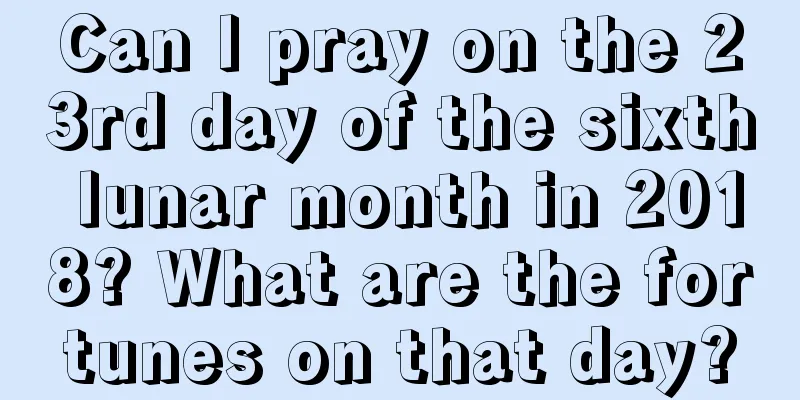What are the customs of Dahan? Introduction to Dahan solar term

Dahan is the last solar term in the 24 solar terms of the lunar calendar. The ancients said, "The cold reaches its extreme, so it is called Dahan." So what are the customs of Dahan? The twelfth month of the lunar calendar is the last month of the year, commonly known as the end of the year. Follow Shuimoxiansheng.com and take a look at the contents of the lunar calendar for December 2018.What are the customs of Dahan?1. Get rid of the old and decorate with the new, prepare New Year's goods . Although the Great Cold is cold, it is close to spring, so it will not be as cold as the period from the Great Snow to the Winter Solstice. At this time of year, people begin to get busy getting rid of the old and decorating with the new, pickling New Year's dishes, preparing New Year's goods and various sacrificial offerings, and sweeping the house, because the most important festival for the Chinese people - the Spring Festival - is about to arrive.2. Steaming and cooking glutinous rice. There is a saying in Lingnan folklore: "Minor Cold and Major Cold, it's cold even without wind." On an extremely cold day in the traditional solar term, the Guangdong people have formed the custom of eating glutinous rice. Nowadays in Guangdong, it is common to see this scene: before the Great Cold arrives, every household cooks a pot of fragrant glutinous rice, mixing it with cured meat, dried shrimp, dried squid, mushrooms, etc., to welcome the coldest day of the traditional solar term. Glutinous rice is sweet and warm in nature, and eating it has the effect of keeping warm and nourishing the body. In Anqing, Anhui, there is a custom of frying spring rolls during the Great Cold. 3. The year-end tooth festival originates from the custom of worshipping the God of Land as the “tooth”. The so-called February 2nd is the first tooth, and from then on every second and sixteenth day of the lunar month, "tooth" will be held. The sixteenth day of the twelfth lunar month is the last tooth. The year-end party, like the second day of the second lunar month, has spring pancakes (called runbing in the south) to eat. On this day, businessmen have banquets, and poached chicken is an indispensable dish at the banquet. It is said that whoever the chicken's head is facing indicates that person the boss will fire in the next year. Therefore, some bosses usually turn the chicken head toward themselves so that their employees can enjoy the food without worry and have a peaceful year after returning home. 4. Buying sesame straw In the old days, during the Great Cold season, people would often rush to buy sesame straw on the streets because "sesame flowers bloom higher and higher." On New Year's Eve, people sprinkle sesame straw on the road for children to crush it, which sounds auspicious like "stepping on the year". The homophony of "broken" and "year" also means "peace every year", hoping for good luck in the new year. This also makes the festival of Dahan, which drives away evil and welcomes good fortune, more meaningful. 5. Offering sacrifices to the Kitchen God: Stick sugar on the Kitchen God’s mouth During the Great Cold, the 23rd day of the twelfth lunar month is the day to offer sacrifices to the Kitchen God, so the custom of offering sacrifices to the Kitchen God is naturally indispensable. Legend has it that the Kitchen God is a god sent by the Jade Emperor to every household to monitor people's daily good and evil deeds. At the end of each year, he returns to the Heavenly Palace to report the people's sentiments to the Jade Emperor and let the Jade Emperor decide on rewards and punishments. Therefore, when sending off the Kitchen God, people put candies, clean water, beans and hay on the table in front of the Kitchen God statue. When offering sacrifices to the Kitchen God, you would melt Guandong sugar with fire and smear it on the Kitchen God's mouth. The purpose of this is to prevent the Kitchen God from saying bad things. 6. The Coldest Days of the Year falls during the “49th day” of severe cold. People in the north have the custom of “drawing pictures to count the nine days”. The pictures include coins, plum blossoms, words, gourds and many other shapes. Among them, the most famous one is “The willow trees in the yard are waiting for the spring breeze”. This kind of tracing paper has nine characters in total, and each character has nine strokes. Starting from the first day of the ninth lunar month, fill in the outlines day by day, one stroke each day. Each time a character is completed, one nine is passed, and when the sentence is complete, ninety-nine and eighty-one days are over. Introduction to the Great Cold Solar Term:Dahan is the last solar term among the 24 solar terms. It occurs when the sun reaches 300° of the ecliptic longitude around January 20 every year. Dahan means the weather is extremely cold. "Shushi Tongkao Tianshi" quotes "Sanli Yi Zong": "Dahan is the middle one, it is better than Xiaohan, so it is called Dahan. It is the coldest time of the year in most parts of my country, with strong winds, low temperatures, and snow on the ground that does not melt, presenting a severe cold scene of ice and snow. The poem says, "The wax trees and silver mountains shine brightly, while the north wind whistles alone and quiets the three rivers. The old farmer still likes the snow in the sky, let alone the fragrance of wheat and fruits next year. (Zuohe Water)" Dahan is the last of the 24 solar terms in China. After Dahan, it is Lichun, which ushers in the cycle of solar terms for a new year.As the saying goes: "Flowers and trees indicate the seasons, and birds' singing heralds the farming season." Flowers, trees, birds, animals and other animals all move according to the seasons, so their regular movements are seen as an important symbol for distinguishing the seasons. In ancient China, the Great Cold was divided into three stages: "The first stage is when chickens lay eggs; the second stage is when migratory birds fly fast; the third stage is when the bellies of fish in marshes become hard." This means that chicks can be hatched during the Great Cold. During the last five days of the year, the ice in the water freezes all the way to the center and is the strongest and thickest, so children can enjoy skating on the river (this activity is only allowed when the average daily temperature remains below -5℃ for several consecutive days, and this activity usually occurs in the area north of the Yellow River). In addition, the flower signs during the Great Cold are "the first sign is Daphne odora, the second sign is orchid, and the third sign is Alum (grown in the south of the Yangtze River)". It can also be used as an important indicator to judge the Great Cold. |
<<: How about the 17th day of the twelfth lunar month in 2019? How is your fortune?
Recommend
Is September 20th of the lunar calendar 2021 a good day? Can I make a bed?
You also need to choose a time to set up the bed. ...
Proverbs about the Beginning of Summer solar term. Is it a good idea to open your business on May 4, the day before the Beginning of Summer in 2020?
Introduction: There are many proverbs about the Be...
Is it suitable to get a haircut on the 25th day of the first lunar month in 2018?
Everyone knows that in my country, before importan...
What does the Spring Festival mean? What are the things that cannot be done during the Spring Festival?
Introduction: The Spring Festival is an important ...
Can I pick up the car on November 17th of the lunar calendar in 2021?
There are certain rules for choosing the time to p...
What is the purpose of the Ghost Festival? What to eat on the Ghost Festival?
Many of my friends have heard of the Ghost Festiva...
Which three days are the Zhongyuan Festival and Ghost Festival? What is the difference between the Zhongyuan Festival and Ghost Festival?
There are three major ghost festivals in China, an...
Why is the date of Mid-Autumn Festival different every year? Should I send gifts to my mother-in-law's family during Mid-Autumn Festival?
Introduction: Mid-Autumn Festival is an important ...
Is it suitable to get a haircut on the Autumnal Equinox in 2022? Is it a good day to get a haircut?
Is it suitable to get a haircut on the Autumnal Eq...
What is the lunar calendar date for April 1, 2017?
Introduction: The Yellow Calendar, also known as t...
What are the five elements of the third month in the lunar calendar and what are its interactions and incompatibilities?
The third month of the lunar calendar is the third...
Is it possible to get engaged on the Dragon Boat Festival in 2019? Is it a good idea to get engaged on the Dragon Boat Festival?
The Dragon Boat Festival holiday is the peak perio...
Is it a good idea to start a business on April 16th of the lunar calendar in 2018?
When starting a business, whether it is to start a...
Analysis of the 29th day of the twelfth lunar month, what should be avoided on the 29th day of the twelfth lunar month in 2017
Introduction: New Year’s Eve is an important day i...
What does the dog days mean and why do we say “the heat is in the dog days”?
Every summer, we often hear people say that the do...









